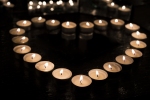August 20, 2014
Thoughts on Ferguson
 I grew up on the line between black and white in St. Louis County.
I grew up on the line between black and white in St. Louis County.
Michael Brown was killed less than ten miles from my childhood home.
Although I haven’t lived in St. Louis for two decades, I know firsthand the deep, persistent, and toxic segregation that is a part of the backdrop for the heartbreak and anger in Ferguson this week.
My white family lived on the white side of the line that meanders through St. Louis County, separating black from white, but only just. As a result, I grew up in a neighborhood that was about 95% white, and attended 6th-12th grade in schools that were about 80% black.
I remember two black families in my neighborhood, one of whom lived right across the street in a newly purchased parsonage belonging to an African American church on other side of the line. Looking back, I wonder what motivated that church to place their pastor’s family on the front lines of integration, and fear to imagine what the decidedly lukewarm welcome the neighborhood provided meant for their hopes and dreams. I know the church sold the house some years later.
As I let the tragedy and outrage of Ferguson penetrate the reaches of my heart, my memory fills with 18-year-old black boys: sweet ones, angry ones, funny ones, ones who loved art and music and drama, ones who aced every math class, ones who never did much homework, ones who did battle with our teachers and ones who went off to do battle for our country, ones I had crushes on, ones who called me out when I was wrong, or racist, or just downright obnoxious. When I imagine Michael Brown, it is as one of those boys -- my classmates -- although of course by now he would really have been one of their sons.
Life on the line in University City, the suburb where I grew up, reflected many -- but not all -- of the dynamics that have fueled rage in Ferguson. Looking back, I can see at least some of the ways that my black classmates’ experience was far different and more painful than mine. At home, the appearance of a police car elicited concern and speculation about what was wrong. At school, several police cars gathered daily, just because.
My classmates and I were there together for those crucial years of our development. We lived segregation, but we also lived in the cracks that the Civil Rights movement had opened. We were raised by black parents who had moved their families into a mixed community and white parents who had stuck it out through waves of white flight.
When I read interviews like the one in the New Republic this week with white St. Louisans who simply cannot imagine Michael Brown and his peers as members of their own families and communities, I wonder if we have not given up too soon and too easily in the fight against segregation.
Segregation is only one tool in racism’s quiver, but it is one that strikes very close to home for the Church, whether we live in communities with militarized police and housing projects, or in the relative safety and comfort of affluent suburbia. The public unraveling of my hometown reveals segregation for what it is: a sin. Sin separates us from God and one another, leaving us unable to see our shared humanity, the equal preciousness of each of our messy lives in God’s sight.
In the church, we mostly accept segregation. Because our neighborhoods are segregated, our churches follow. Because we are voluntary institutions, the people our churches attract most often mirror the existing congregation in race and class. We celebrate multiculturalism as cool, but make a thousand excuses for giving up on the hard work of making real space for everyone. Our world and our God need us to be able to see one another’s children as our own. We live in a still-segregated country, despite much love and blood poured out to make it otherwise. Can we rise to the challenge of opening the cracks in that sinful reality, wherever it is that we find ourselves?





